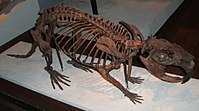
Photo from wikipedia
This is a multi-individual (n = 11), stable carbon and nitrogen isotope study of bone collagen (δ13Ccol and δ15Ncol) from the giant beaver (genus Castoroides). The now-extinct giant beaver was once one… Click to show full abstract
This is a multi-individual (n = 11), stable carbon and nitrogen isotope study of bone collagen (δ13Ccol and δ15Ncol) from the giant beaver (genus Castoroides). The now-extinct giant beaver was once one of the most widespread Pleistocene megafauna in North America. We confirm that Castoroides consumed a diet of predominantly submerged aquatic macrophytes. These dietary preferences rendered the giant beaver highly dependent on wetland habitat for survival. Castoroides’ δ13Ccol and δ15Ncol do not support the hypothesis that the giant beaver consumed trees or woody plants, which suggests that it did not share the same behaviours as Castor (i.e., tree-cutting and harvesting). The onset of warmer, more arid conditions likely contributed to the extinction of Castoroides. Six new radiocarbon dates help establish the chronology of the northward dispersal of the giant beaver in Beringia, indicating a correlation with ice sheet retreat.
Journal Title: Scientific Reports
Year Published: 2019
Link to full text (if available)
Share on Social Media: Sign Up to like & get
recommendations!